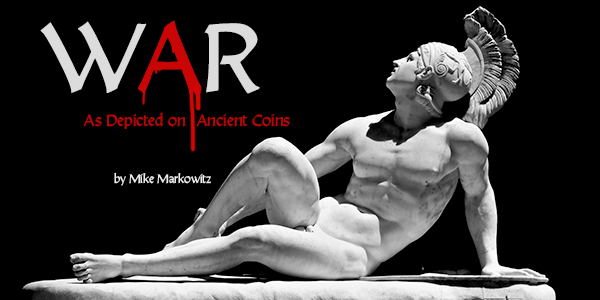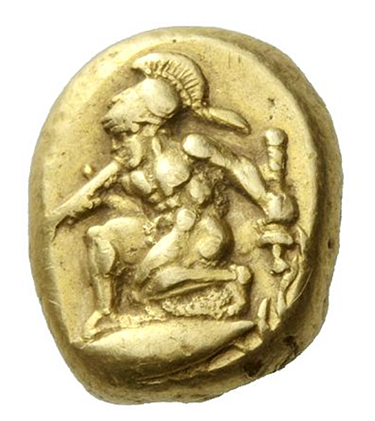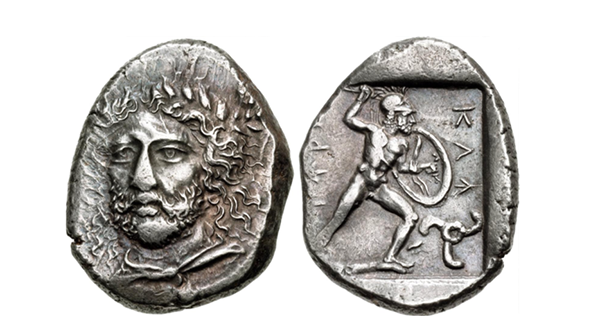
CoinWeek Ancient Coin Series by Mike Markowitz …..
WAR IS MUCH older than coinage. For much of human history, warfare has absorbed our resources, energy, and creativity. One of the earliest images of war in Western art is the “Battlefield Palette”, a carved slate from pre-Dynastic Egypt dated c. 3100 BCE[1]. It depicts the aftermath of a border skirmish. A lion and vultures feast on the dead while bound captives are led away. War is prominent in early Egyptian, Mesopotamian, and Greek art.
One explanation offered for the invention of coinage is that coins provide a convenient, compact way to pay mercenaries. But images of war are not common on coins, and when they appear they reflect three basic themes:
—Depiction of battle is “sanitized”. The horror, bloodshed, filth, and dismemberment of ancient combat are played down in favor of noble, heroic, and triumphant images.
—Weapons and modes of fighting used by aristocrats are strongly emphasized. For example, we often see elite horsemen spearing foot soldiers.
—Coins tell war stories. We see images users would recognize as familiar persons or events. In a world where most people were illiterate, such images were a kind of official propaganda.
Sanitized Battle
 The Assyrian Empire (c. 2025 – 599 BCE) was not squeamish about depicting the reality of war. Impaled prisoners, decapitated heads and severed limbs of enemies adorn carved panels that decorated royal palaces[2]. Ancient Greeks were far more restrained in their depiction of combat. Moderation in all things was a core Greek value.
The Assyrian Empire (c. 2025 – 599 BCE) was not squeamish about depicting the reality of war. Impaled prisoners, decapitated heads and severed limbs of enemies adorn carved panels that decorated royal palaces[2]. Ancient Greeks were far more restrained in their depiction of combat. Moderation in all things was a core Greek value.
The imagery of war in Greek sculpture, vase paintings, and coins is “sanitized”. Artists strove to capture the athletic grace and muscular prowess of warriors, rather than the grim mechanics of killing. Some of the earliest images of warriors on coins appear on electrum staters of Cyzicus (c. 500 – 450 BCE). On one type, a kneeling warrior, naked except for his helmet, blows a war trumpet while holding a sheathed sword[3]. “Heroic nudity” was a convention of Greek art, but it was also a practical military adaptation to the hot climate. It also reduced the danger of infection from fibers of dirty garments driven into wounds.
The classic Greek combat formation was the phalanx. Foot soldiers called hoplites stood shoulder-to-shoulder carrying large round shields and eight-foot spears. The clash of two phalanxes was a lethal shoving match; the side that broke first suffered most of the casualties. Phalanx combat developed around the same time as coinage and dominated ancient Mediterranean warfare until the Roman legion defeated the Macedonian army of Philip V at Cynoscephalae in 197 BCE[4]. The earliest image of hoplites in formation appears on the Chigi Vase, a fragmentary painted ceramic dated to around 650 BCE[5]. A silver stater of Tarsus circa 400 BCE[6] provides an excellent picture of a fully-armed hoplite, wearing a protective skirt of leather flaps.

Hoplites were much in demand as mercenaries by non-Greek rulers, and a stater (c. 380-360 BCE) from the kingdom of Lycia depicts a typical mercenary with sword and shield[7]. Greek art often details the interior face of the shield with its strap and handle, rather than the painted exterior. The bronze sword was a last-resort Greek weapon, used if the spear broke.
Riders Spearing Foes
“…you must remember that ten thousand cavalry only amount to ten thousand men. No one has ever died in battle through being bitten or kicked by a horse; it is men who do whatever gets done in battle.”
—Xenophon (c. 430 – 354 BCE)
Aristocrats who could afford to maintain a horse fought as cavalry, not as hoplites[8]. The image of a rider spearing a foot soldier first appears on a classic silver didrachm of the Greek city of Gela in Sicily about 425 BCE[9]. The art of coin die engraving reached a high level of excellence in this era, and the rival towns of Sicily vied with one another to produce the most striking and elegant designs.
A silver tetradrachm of Paeonia, c. 340 – 315 BCE shows a vigorous barbaric version of the scene. The Paeonians were a non-Greek tribe of the Balkans who provided light cavalry scouts for the army of Alexander the Great (ruled 336 – 323 BCE).

Centuries later, the classic image of a rider spearing a fallen foot soldier still appealed to the Roman elite[10], and a stunning example is a gold aureus of Trajan dated c. 104 – 107 CE[11]. In this dramatic scene, the emperor’s horse is about to trample a barbarian, while the emperor himself prepares to hurl a javelin into the hapless foe. Under Trajan, a talented military leader, the empire reached its greatest territorial extent, fighting wars against Dacia (now Romania) and Parthia (now Iraq and Iran).
On the very common bronze coinage of Constantius II we see a remarkable transformation of the “horseman spearing foot soldier”[12]. Here, a Roman officer on foot drives his spear into the back of a fallen barbarian horseman. The Roman is much larger than the barbarian, emphasizing the dramatic asymmetry of this powerful image.
War Elephants and War Chariots
The elephant is often (erroneously) described as the “tank” of ancient warfare[13]. Costly to maintain and difficult to control in battle, they were largely psychological weapons, intended to strike terror into men and horses unfamiliar with them. The most remarkable image of a war elephant in battle is a very rare silver medallion struck circa 325 BCE at Babylon to commemorate Alexander’s campaign in India. The reverse shows Alexander on his famous horse Bucephalus, charging the war elephant of the Indian ruler Porus at the Battle of Hydaspes (May, 326 BCE).
Most chariots that appear on ancient coins are racing or ceremonial vehicles, often carrying gods. A rare example of a war chariot in action appears on a silver tetradrachm that was probably struck as part of the same commemorative series[14]. A four-horse Indian chariot gallops right, with a driver and an archer who draws a longbow. See below for another example.
Stories on Coins
In the Roman republic the junior officials responsible for coinage often used coin designs (which changed frequently) to promote their political careers. They often did this by celebrating the heroic deeds of their ancestors in the republic’s many wars. A good example is a denarius of 127 BCE issued by C. Servilius Vatia[15]. The Servilii were a large and important aristocratic clan[16]. On the coin we see a battle between two mounted warriors. The central figure is M. Servilius Pulex Geminus, consul in 202 BCE and famous for surviving numerous wounds in 23 victorious single combats.
On a fairly common denarius of Q. Minucius Thermus (103 BCE) a Roman soldier fights a barbarian to protect a fallen comrade. Saving the life of a fellow Roman in battle was one of the highest honors a soldier could achieve, rewarded with the corona civica, a wreath of oak leaves[17]. One of the many distinguished ancestors of Minucius earned this award, and the coin recalls the event.
Coins also told current war stories. A fine example is the denarius of Lucius Hostilius Saserna, a mint official (triumvir monetalis) in 48 BCE[18]. We know little about him, but two of his brothers Publius and Gaius were officers in Julius Caesar’s army. The coin celebrates Caesar’s victories over the Gauls (58 – 50 BCE). The obverse is a powerful portrait of a Gallic warrior, possibly Vercingetorix, who led a revolt against the Romans. The reverse shows an unusually detailed Gallic two-horse war chariot, with a driver and javelin-armed warrior.
Fighting Emperors

Roman emperors commonly depended on the army for their position and their survival. On the coinage, they often tried to portray themselves as a fellow soldier and best friend to the troops, even if they were timid palace dwellers, who never took the field. A rare and magnificent bronze sestertius of Caligula (37-38) shows him addressing the massed ranks of the Praetorian Guard[19]. Four eagle standards indicate that four cohorts (units of several hundred guards) were present, even though the engraver only depicts five men.
As the empire came under increasing stress from barbarian invasions, the depiction of the emperor on coins abandons the peaceful toga and adopts military dress. A striking example is the rare silver miliarensis of Theodosius II (ruled 408-450)[20]. On the reverse, the young emperor (who never actually campaigned) stands bare-headed in armor, holding a spear and shield. The halo that appears around his head is not standard military issue, but rather a symbolic indication of his semi-divine status.
The gold coinage of Isaac I was unfavorably commented on by contemporaries because of its ostentatiously military character … for it seemed to imply that the emperor believed he owed his throne to his military qualities, not to divine decree (Grierson, 759-60).
One of the last “fighting emperors” to appear as such on a coin was Isaac I Comnenus (ruled 1057 – 1059). A successful general, he led a revolt that forced the ineffective Emperor Michael VI to abdicate in his favor. He broke with tradition by having himself depicted on his gold histamenon in military garb, holding a drawn sword[21]. This offended the powerful monks, and subsequent emperors returned to conventional religious Imperial regalia on their coin portraits; a globe topped by a cross and the labarum, a ceremonial staff.
* * *
Notes
[1] Two fragments survive, one in the British Museum, the other in Oxford’s Ashmolean Museum: https://en.wikipedia.org/wiki/Battlefield_Palette
[2] For a famous example, see: https://commons.wikimedia.org/wiki/File:JudeanImpalement_Roaf185.jpg
[3] NAC Auction 72, 16 May 2013, Lot 374. Realized $30,224 USD
[4] See https://coinweek.com/ancient-coins/coinweek-ancient-coin-series-decline-fall-macedon/
[5] https://en.wikipedia.org/wiki/Chigi_vase
[6] CNG Auction 96, 14 May 2014, Lot 513. Realized $900
[7] CNG Auction 99, 13 May 2015, Lot 303. Realized $9,000
[8] https://coinweek.com/ancient-coins/coinweek-ancient-coin-series-horses-ancient-coins/
[9] New York Sale XXVII, 4 January 2012, Lot 125. Realized $7,500
[10] A modern echo of this iconic image is St. George spearing a dragon, which still appears on the reverse of the British gold sovereign.
[11] Roma Numismatics Auction XIII, 23 March 2017, Lot 807. Realized $37,580
[12] Roma Numismatics E-sale 35, 3 May 2017, Lot 1118. Realized $52
[13] See https://coinweek.com/ancient-coins/elephants-ancient-coins/
[14] New York Sale XXVII, 4 January 2012, Lot 306. Realized: 37,500
[15] NAC Auction 100, 29 May 2017, Lot 1409.Realized $205
[16] Classics fans may recall that Servilia (c. 104 – 42 BCE) was the mother of Brutus and the lover of Julius Caesar: https://en.wikipedia.org/wiki/Servilia_(gens)
[17] https://en.wikipedia.org/wiki/Civic_Crown
[18] NAC Auction 100, 29 May 2017, Lot 343. Realized $2,311
[19] NAC Auction 54, 24 March 2010, Lot 33o. Realized $34,605
[20] CNG Electronic Auction 322, 12 March 2014, Lot 639. Realized $1,600
[21] CNG Auction 102, 18 May 2016, Lot 1199. Realized $1,400
References
Ferrill, Arthur. The Origins of War: From the Stone Age to Alexander the Great. London. (1985)
Grierson, Philip. Catalogue of the Byzantine Coins in the Dumbarton Oaks Collection: Volume III, Part 2. Washington (1973)
Hanson, Victor D. (ed.) Hoplites: The Classical Greek Battle Experience. London (1991)
Hanson, Victor D. The Wars of the Ancient Greeks. London (1999)
Holt, Frank L. Alexander the Great and the Mystery of the Elephant Medallions. Berkeley (2003)
Keegan, John. The Face of Battle. London (1976)
Lendon, J.E. Soldiers and Ghosts: A History of Battle in Classical Antiquity. New Haven (2005)
Xenophon (tr. Rex Warner). The Persian Expedition. Baltimore (1949)
Gold Ancient Coins Currently Available on eBay
[wpebayads]




